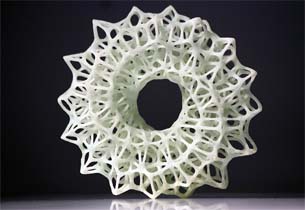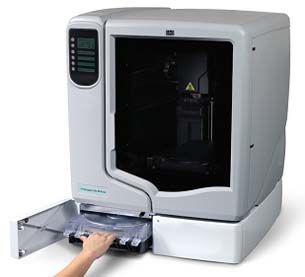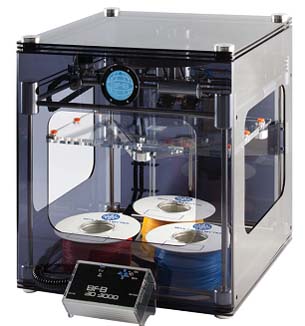July 1, 2010
By Susan Smith
 This “Mobius Net” decorative art was printed in a milky white matte glass material from Shapeways. It was designed by Shapeways shop owner Bathsheba Grossman. |
There are a number of trends gaining momentum in additive manufacturing; and the need for and development of new materials with increasing strength, flexibility, texture, and other qualities continues.
First Ever Standards
Originally used for building physical representations of products, additive manufacturing has evolved into an important tool for building usable parts and products. The term “additive manufacturing” is the result of a collaboration of the Society of Manufacturing Engineers and ASTM International to describe this process and set it apart from subtractive processes such as CNC milling.
“Rapid prototyping has meant different things to different manufacturers. It means quick prototyping to one and layered manufacturing to another. Now it’s called additive manufacturing,” explains Brent Stucker, Ph.D., in a recent press release. Stucker is a member of SME’s Rapid Technologies and Additive Manufacturing (RTAM) Community and an associate professor of mechanical and aerospace engineering at Utah State University.
SME’s RTAM community approached ASTM to develop the industry’s first-ever standards as part of an effort to streamline communication in terms of terminology, design, testing methods, materials, and processing differences.
To address the issue, ASTM formed the Committee F42 on Additive Manufacturing, which includes members of the RTAM community, to write new standards. The initial result is the publication “Standard Terminology for Additive Manufacturing Technologies,” now available for purchase online.
ASTM says these new standards will “allow manufacturers to compare and contrast the performance of different additive processes … ]and] enable researchers and process developers to provide repeatable results.”
 The HP Designjet Color 3D Printer represents a first: Stratasys announced the delivery of its first shipment of HP-branded 3D printers for the hardware manufacturer. |
Medical/Dental
Still one of the most promising industries for additive manufacturing is medical/dental. Most progress is taking place in Europe, where orthopedics leads the way as one of the fastest growing sectors of manufacturing. Reconstructive devices, spinal implants, arthroscopy, orthobiologicals, hip implants, and knee replacement are among the applications. In the past 18 months, the U.S. has been catching up, especially with the production of copings for crowns and bridges and coating materials for dental applications.
Coatings are also important for implantable medical devices, which have special requirements for wear resistance, increased bony in-growth, and reduced friction. Coatings may need to be biocompatible to avoid harmful interaction with body systems.
Cardiovascular devices constitute the largest segment in the medical device market. These include a wide range of products that make contact with the vasculature or heart: pacemakers, defibrillators, drug-eluting stents, catheters, artificial hearts, and ventrical support systems.
Aerospace
An EOS customer, Royal Plastic Manufacturing, Inc. produces advanced composite parts as an “outsource” manufacturer for larger aerospace and defense companies. Royal has purchased the first EOSINT P 800 system in the U.S. and uses it to sinter high-temperature thermoplastics. Royal also furthers EOS’ technology by optimizing the SLS process and developing a PEEK material in cooperation with the U.S. Navy and U.S. Air Force, as well as OEMs, meeting high tolerance capabilities certified to aerospace specifications.
According to a news item on SME’s website, Boeing is using rapid prototyping to build an unmanned aerial vehicle (UAV) and link it with a liquid-hydrogen propulsion system; the UAV is expected to be ready for flight next year.
About half the materials used in the building of the Boeing 787 Dreamliner are composites. The design includes increased use of lightweight and high durability composites and advanced aluminum alloys. Carbon fiber and epoxy composites, and titanium graphite laminate have been used in the construction of the low sweptback wings and composites are also used for the nose section.
Gaming and Other Emerging Markets
The availability of color 3D printing in the form of Z Corporation 3D printers has spawned a new generation of toys. The company FigurePrints, founded by former Microsoft vice president Ed Fries, produces 3D figures created from World of Warcraft game characters created by players. Participants order the figures online and they are built into actual statues using Z Corporation Spectrum Z510 printers.
Demand for FigurePrints is so high that orders are filled on a lottery basis.
Other figurine businesses (ones not linked to gaming) include KarbonKids, wherein a consumer can produce a little figure by choosing from a selection of 500 distinct aspects, each figure taking a mere five minutes to produce. Another is Thatsmyface.com. A consumer submits two jpeg images of him or herself, and using a product called FaceGen can get a figure with their face on an action figure or Barbie doll for $299. This is also accomplished with a ZCorp 3D printer.
 The RapManPRO 3000 is the new “big brother” to the RapManUSA Rapid-Prototyping Kit. It is shipped fully-assembled and is considered a budget-friendly fully-functioning, multi-color-capable 3D Printer. |
Do-It-Yourself Systems (DIY)
Companies such as Bits From Bytes (BFB), MakerBot Industries, and the NextFab Store have been selling a lot of machines based on open-source developments. They allow consumers to get into the act by building their own parts and products.
Consultant Terry Wohlers said that these companies have developed “almost a cult-like following,” of younger engineering and grad students who like to make things. “The systems can be bought as kits that they assemble and use to make parts from their 3D CAD data.”
Of course, there is not the kind of industry level part quality to be found with higher-end systems from Objet, Stratasys or 3D Systems. RepRap machines and kits retail for far less and are generally used for prototyping or to create products that do not adhere to industry standards … yet.
Not itself a printer kit, the BFB RapManPRO 3000 is a similar product that comes fully assembled. This product makes it possible to make more complex build-parts with support, to do so faster, and to build multiple models simultaneously using multiple colors.
Another concept that has been around for a while, but which may now take root more deeply is that of making parts for machines with those machines. For many years, EOS has made as many as 20 parts with its Formiga 100 system for that very system. Stratasys’ biggest machine – the FDM900mc, also includes a number of FDM-manufactured parts.
According to Peter Weijmarshausen, CEO of Shapeways, his company offers more of a “marketplace and community” with the aim of making 3D printing technology accessible to consumers. Via its website, the company offers a suite of enabling tools that make it easy for 3D software users to upload and check their models, get instant price quoting, and buy their products. It is also designed for non-3D software users to customize existing designs or buy items from the shops of 3D software users.
Shapeways enables consumers to use their own 3D software to design a product themselves, or open a shop and sell their items at Shapeways to others who don’t have those skills. Consumers can also make their items customizable, so that people without 3D skills can adapt templates, make a mockup, and Shapeways will then produce the item.
Shapeways currently offers FDM, SLS (different types of materials, different colors), ZCorp, and will re-introduce Alumide, a mix of nylon and aluminum dust. They also offer Objet white, black, and transparent materials, stainless steel and the newly introduced first commercial offering of 3D printing of glass from ExOne. Shapeways does not own its own machines, but outsources production. It has close to 40,000 members and the website has approximately 650 shops run by community members, home to more than 9,000 products.
Systems with a Fresh Approach
Although Objet Geometries came out with the Connex500 in 2007 (the first system to support multi-material 3D printing), it is noteworthy here as it was followed in 2009 by Connex350, a smaller version of the Connex500.
Product developers can print parts and assemblies made of several materials with different mechanical and physical properties in a single build process using the systems’ patented PolyJet Matrix Technology. The systems jet materials in ultra-thin layers, immediately curing each layer with UV light. This technology makes it possible for users to pre-set mechanical properties that they want in composite materials. The resulting models closely resemble the look, feel, and function of finished products.
The agreement between 3D printing company Solido and CAD software and service provider SolidVision, meant that Solido’s 3D desktop prototype printer, the SD300 Pro 3D printer ($9,950), could be brought to SolidVision’s broad base of CAD users. By using their CAD data to directly build in-house designs, users could use those specifications to cut, glue, and layer engineered plastic sheets from a spool, a process known as laminated object manufacturing (LOM).
Previous attempts at LOM had met with criticism because it wasn’t capable of producing high detail and resulted in hazardous waste—the SD300 Pro changes that. The SD300 produces detailed, functional parts within 0.1mm accuracy, cuts down on waste, and any excess material and consumable containers are recycled by the company.
Another technology that has been written about but is not yet available is Huntsman Advanced Materials’ Araldite Digitalis, a new polymeric additive fabrication system that company spokesmen say is capable of manufacturing large numbers of parts simultaneously at speeds with a pinpoint accuracy not previously possible. It uses the MLS MicroLightSwitch, a new exposure system operating via a computer controlled micro-mechanical shutter system. This system makes it possible for a large surface area of radiation-curable resin to be selectively exposed in a single step, resulting in fast uniform exposure with high accuracy.
Higher-End Systems
Advancements in higher-end systems offering FDM and laser sintering, such as Stratasys Inc. and EOS, range from new relationships to controlled production variables.
Recently Stratasys announced the delivery of its first shipment of HP-branded 3D printers. This is a first for the 3D printer manufacturer: co-developing an exclusive line of 3D printer systems for a major hardware manufacturer. As part of a global manufacturing agreement with HP, the product was developed and manufactured to HP’s specification.
Dimension 3D Printing, a brand of Stratasys Inc., recently introduced WaveWash, an environmentally safe cleaning system that dissolves the support material from models made with Dimension 3D Printers. Press materials say the cleaning system is as easy to use as a household dishwasher.
EOS announced its Parts Property Management (PPM) and Parts Property Profile (PPP) capabilities in laser-sintering, particularly plastics. By selecting a laser-sintering speed and part quality, EOS can now provide the kind of controlled production variables that are necessary for optimizing manufacturing costs.
EOS’ new metals, a nickel super alloy and an aluminum alloy, are intended for series part production and will advance the number of manufacturing applications for laser-sintering in the coming years.
On the Horizon
What will be game changing in the future? It seems that some of these business models, such as RepRap, Shapeways “communities,” and the Stratasys partnership with HP, pave the way for new thinking about ways to use and market additive manufacturing. Although not a new trend, there is also concern about how waste materials from additive processes are disposed of, and what impact they have on our environment.
New processes and materials such as the 3D printing of glass, the ability to use CAD data to directly build in-house designs, the MLS MicroLightSwitch technology that promises high accuracy, new metals and composite materials for medical/dental and aerospace and defense all contribute to shaping the future—perhaps a future in which machines will indeed be used to replicate themselves.
More Info:
Society ofManufacturing Engineers
Contributing Editor Susan Smith is DE’s expert in rapid technologies and has been immersed in the tech industry for more than 17 years. Send e-mail about this article to [email protected].
Subscribe to our FREE magazine, FREE email newsletters or both!
About the Author
DE’s editors contribute news and new product announcements to Digital Engineering.
Press releases may be sent to them via [email protected].






